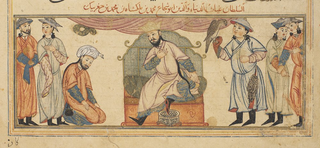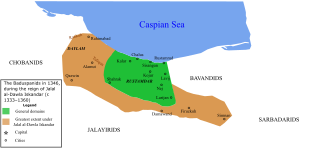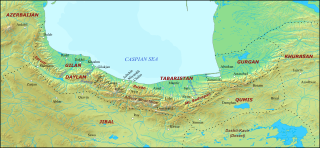Related Research Articles

Muhammad I was a son of Seljuq Sultan Malik Shah I. In Turkish, Tapar means "he who obtains, finds".

Safi-ad-din Ardabili was a Kurdish poet, mystic, teacher and Sufi master. He was the son-in-law and spiritual heir of the Sufi master Zahed Gilani, whose order—the Zahediyeh—he reformed and renamed the Safaviyya, which he led from 1301 to 1334.

Mazyar, was an Iranian prince from the Qarinvand dynasty, who was the ruler (ispahbadh) of the mountainous region of Tabaristan from 825/6 to 839. For his resistance to the Abbasid Caliphate, Mazyar is considered one of the national heroes of Iran by twentieth-century Iranian nationalist historiography. His name means "protected by the yazata of the moon".

The Bavand dynasty, or simply the Bavandids, was an Iranian dynasty that ruled in parts of Tabaristan (Mazandaran) in what is now northern Iran from 651 until 1349, alternating between outright independence and submission as vassals to more powerful regional rulers.

The kanārang was a unique title in the Sasanian military, given to the commander of the Sasanian Empire's northeasternmost frontier province, Abarshahr. In Byzantine sources, it is rendered as chanaranges and often used, for instance by Procopius, in lieu of the holder's actual name.

The King of Saudi Arabia is the monarchial head of state and head of government of Saudi Arabia who holds absolute power. He is the head of the Saudi Arabian royal family, the House of Saud. The king is called the "Custodian of the Two Holy Mosques", a title that signifies Saudi Arabia's jurisdiction over the mosques of Masjid al Haram in Mecca and Al-Masjid an-Nabawi in Medina, the title has been used many times through the history of Islam. The first Saudi monarch to use the title was King Faisal, however, King Khaled did not use the title after him. In 1986, King Fahd replaced "His Majesty" with the title of Custodian of the Two Holy Mosques, and it has been ever since used by both King Abdullah and King Salman bin Abdulaziz.
Bahā’ al-Dīn Muḥammad ibn Ḥasan ibn Isfandiyār was a 13th-century Iranian historian from Tabaristan, who wrote a history of his native province, the Tarikh-i Tabaristan. What little is known of his life comes from the introduction of this work.

The Baduspanids or Badusbanids were a local dynasty of Tabaristan which ruled over Ruyan/Rustamdar. The dynasty was established in 665, and ended in 1598 when the Safavids invaded their domains.
Buzurg Ibn Shahriyar of Ramhormuz, was allegedly a Muslim traveler, sailor, cartographer and geographer who was born in Khuzistan in Persia. In the year 953 he supposedly completed a collection of narratives from Muslim sailors based in Siraf, Oman, Basra and elsewhere.
Shapur was the seventh ruler of the Bavand dynasty, who ruled briefly in 825. He was the son and successor of Shahriyar I.
Shahriyar I was the sixth ruler of the Bavand dynasty from 817 to 825. He was the grandson and successor of Sharwin I. Before Shahriyar became ruler of the Bavand dynasty, he was taken as hostage by Harun al-Rashid to Baghdad, where Shahriyar stayed for four years until he was allowed to return to Tabaristan.
Qarin I, was the eighth ruler of the Bavand dynasty from 839 to 867.
Jalal al-Dawla Iskandar was the ruler (ustandar) of the Baduspanids from 1333 to 1360. Under his rule, the kingdom reached its zenith. Taking advantage of the collapse of the Mongol Ilkhanate in 1335, he expanded his rule into the southern Alborz, ruling an area stretching from Qazvin to Simnan. In 1346, he founded the town of Kojur and conquered the region of Daylam. In 1360, he was mortally wounded by his bodyguard during a ruckus at a drinking party. He died three days later, and was succeeded by his brother Fakhr al-Dawla Shah-Ghazi.
Al-Marzuban or Marzuban bin Rustam of Parim, was the thirteenth ruler of the Bavand dynasty from 979 to 986. He was the son and successor of Rustam II. In some sources, his name was changed to Rustam ibn al-Marzuban, which caused confusion among the historians, and made them think that they were two people.

The Qarinvand dynasty, or simply the Karenids, was an Iranian dynasty that ruled in parts of Tabaristan (Mazandaran) in what is now northern Iran from the 550s until the 11th-century. They considered themselves as the inheritors of the Dabuyid dynasty, and were known by their titles of Gilgilan and Ispahbadh. They were descended from Sukhra, a Parthian nobleman from the House of Karen, who was the de facto ruler of the Sasanian Empire from 484 to 493.

Kiya Abu'l-Fawaris Shahriyar ibn Abbas ibn Shahriyar, better simply known as Shahriyar ibn Abbas was a Bavandid prince, who is solely known for being mentioned in the inscription on the mausoleum in Savadkuh, known as the Lajim Tower. The mausoleum was constructed in 1022, where he was most already likely dead. The person who ordered the construction was his mother Chihrazad, whilst the name of the architect was a certain al-Husayn ibn Ali. In the inscription, Shahriyar is labeled as "Client of the Commander of the Faithful". However, he is not called ispahbad, which was the title used by the Bavandid rulers, and thus it is dubious if he ever ruled.

Ruyan, later known as Rustamdar (رستمدار), was the name of a mountainous district that encompassed the western part of Tabaristan/Mazandaran, a region on the Caspian coast of northern Iran.
Kayumarth I was the ruler (ustandar) of the Baduspanids from 1394 to 1453, with a three-year interruption. An active expansionist ruler, his kingdom experienced a resurgence during his long reign, which included the reconquest of Rustamdar. He was often at odds with his suzerain, the Timurid ruler Shah Rukh. After his death, a dynastic struggle followed, which resulted in his kingdom being split up by his sons Iskandar IV and Ka'us II, in Kojur and Nur respectively.
Afridun ibn Karan was a Baduspanid prince, who came from a collateral line of the family, known as the Afridunids. He seized the throne in 884, thus overthrowing the main branch of the family descended from Baduspan I and initiating the rule of the Afridunids, who would rule until 937, when Shahriyar III ibn Jamshid of the Shahriyarid branch established his rule.
Ostandar or Ustandar was an administrative title wielded by provincial governors under the Sasanian Empire. They governed the royal lands, known as the ostan. The title was later assumed by the Baduspanids of Ruyan, starting with Shahriyar III ibn Jamshid.